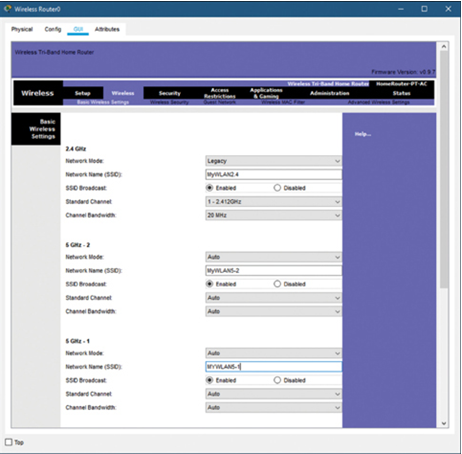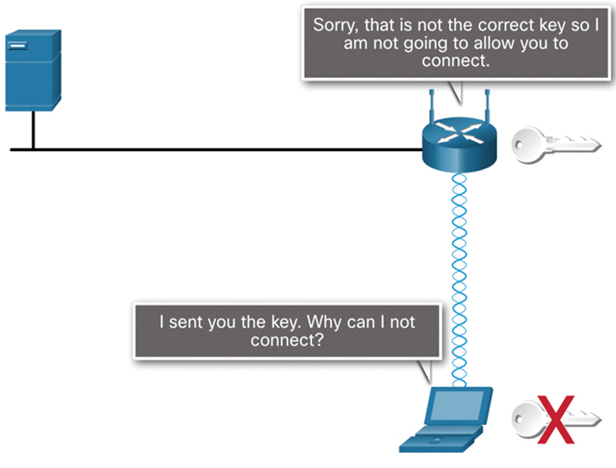Troubleshoot Wireless Issues (36.3)
Troubleshooting a wireless LAN is similar to troubleshooting a wired LAN, but there are some important differences associated with the wireless signal and the access point.
Causes of Wireless Issues (36.3.1)
If the wireless client is unable to connect to the AP, it may be because of wireless connectivity problems. Wireless communications rely on radio frequency (RF) signals to carry data. Many factors can affect our ability to connect hosts using RF:
• Not all wireless standards are compatible. The 802.11ac (5 GHz band) is not compatible with the 802.11b/g/n standards (2.4 GHz band). Within the 2.4 GHz band, each standard uses different technology. Unless specifically configured, equipment that conforms to one standard may not function with equipment that conforms to another. In Figure 36-6, the 2.4 GHz network is configured to support legacy devices.
• Each wireless conversation must occur on a separate, nonoverlapping channel. Some AP devices can be configured to select the least congested or highest throughput channel. Although automatic settings work, manual setting of the AP channel provides greater control and may be necessary in some environments.
• The strength of an RF signal decreases with distance. If the signal strength is too low, devices will be unable to reliably associate and move data. The signal may be dropped. The NIC client utility can be used to display the signal strength and connection quality.
• RF signals are susceptible to interference from outside sources, including other devices functioning on the same frequency. A site survey should be used to detect for this.
• APs share the available bandwidth between devices. As more devices associate with the AP, the bandwidth for each individual device will decrease, causing network performance problems. The solution is to reduce the number of wireless clients using each channel.

Figure 36-6 Basic Wireless Settings on a Wireless Router
Authentication and Association Errors (36.3.2)
Modern WLANs incorporate various technologies to help secure the data on the WLAN. Incorrect configuration of any of these can prevent communication. Some of the most common settings that are configured incorrectly include the SSID, authentication, and encryption.
• The SSID is a case-sensitive, alphanumeric string that is up to 32 characters. It must match on both the AP and client. If the SSID is broadcast and detected, this is not an issue. If the SSID is not broadcast, it must be manually entered onto the client. If the client is configured with the wrong SSID, it will not associate with the AP. Additionally, if another AP is present that has broadcasted the SSID, the client may automatically associate to it.
• On most APs, open authentication is configured by default, allowing all devices to connect. If a more secure form of authentication is configured, a key is necessary. Both the client and the AP must be configured with the same key. If the keys do not match, authentication will fail, and the devices will not associate.
• Encryption is the process of altering the data so that it is not usable by anyone without the proper encryption key. If encryption is enabled, the same encryption key must be configured on both the AP and the client. If the client associates with the AP but cannot send or receive data, the encryption key may be the issue, as shown in Figure 36-7.

Figure 36-7 Failed Authentication
Packet Tracer—Troubleshoot a Wireless Connection (36.3.3)
In this activity, you will be given a scenario. You will determine the reason why a wireless client is unable to connect to a wireless router and correct the problem.
Refer to the online course to complete this Packet Tracer.
